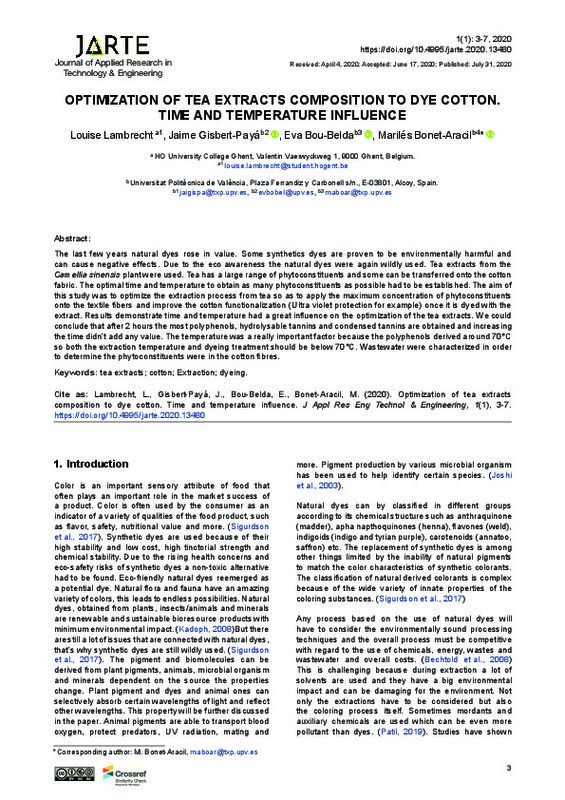JavaScript is disabled for your browser. Some features of this site may not work without it.
Buscar en RiuNet
Listar
Mi cuenta
Estadísticas
Ayuda RiuNet
Admin. UPV
Optimization of tea extracts composition to dye cotton. Time and temperature influence
Mostrar el registro sencillo del ítem
Ficheros en el ítem
| dc.contributor.author | Lambrecht, Louise
|
es_ES |
| dc.contributor.author | Gisbert Paya, Jaime
|
es_ES |
| dc.contributor.author | Bou-Belda, Eva
|
es_ES |
| dc.contributor.author | Bonet Aracil, María Angeles
|
es_ES |
| dc.date.accessioned | 2020-07-24T09:25:22Z | |
| dc.date.available | 2020-07-24T09:25:22Z | |
| dc.date.issued | 2020-07-21 | |
| dc.identifier.uri | http://hdl.handle.net/10251/148629 | |
| dc.description.abstract | [EN] The last few years natural dyes rose in value. Some synthetics dyes are proven to be environmentally harmful and can cause negative effects. Due to the eco awareness the natural dyes were again wildly used. Tea extracts from the Camellia sinensis plant were used. Tea has a large range of phytoconstituents and some can be transferred onto the cotton fabric. The optimal time and temperature to obtain as many phytoconstituents as possible had to be established. The aim of this study was to optimize the extraction process from tea so as to apply the maximum concentration of phytoconstituents onto the textile fibers and improve the cotton functionalization (Ultra violet protection for example) once it is dyed with the extract. Results demonstrate time and temperature had a great influence on the optimization of the tea extracts. We could conclude that after 2 hours the most polyphenols, hydrolysable tannins and condensed tannins are obtained and increasing the time didn’t add any value. The temperature was a really important factor because the polyphenols derived around 70 °C so both the extraction temperature and dyeing treatment should be below 70 °C. Wastewater were characterized in order to determine the phytoconstituents were in the cotton fibres. | es_ES |
| dc.language | Inglés | es_ES |
| dc.publisher | Universitat Politècnica de València | es_ES |
| dc.relation.ispartof | Journal of Applied Research in Technology & Engineering | es_ES |
| dc.rights | Reconocimiento - No comercial - Compartir igual (by-nc-sa) | es_ES |
| dc.subject | Tea extracts | es_ES |
| dc.subject | Cotton | es_ES |
| dc.subject | Extraction | es_ES |
| dc.subject | Dyeing | es_ES |
| dc.title | Optimization of tea extracts composition to dye cotton. Time and temperature influence | es_ES |
| dc.type | Artículo | es_ES |
| dc.identifier.doi | 10.4995/jarte.2020.13480 | |
| dc.rights.accessRights | Abierto | es_ES |
| dc.contributor.affiliation | Universitat Politècnica de València. Departamento de Ingeniería Textil y Papelera - Departament d'Enginyeria Tèxtil i Paperera | es_ES |
| dc.contributor.affiliation | Universitat Politècnica de València. Escuela Politécnica Superior de Alcoy - Escola Politècnica Superior d'Alcoi | es_ES |
| dc.description.bibliographicCitation | Lambrecht, L.; Gisbert Paya, J.; Bou-Belda, E.; Bonet Aracil, MA. (2020). Optimization of tea extracts composition to dye cotton. Time and temperature influence. Journal of Applied Research in Technology & Engineering. 1(1):3-7. https://doi.org/10.4995/jarte.2020.13480 | es_ES |
| dc.description.accrualMethod | OJS | es_ES |
| dc.relation.publisherversion | https://doi.org/10.4995/jarte.2020.13480 | es_ES |
| dc.description.upvformatpinicio | 3 | es_ES |
| dc.description.upvformatpfin | 7 | es_ES |
| dc.type.version | info:eu-repo/semantics/publishedVersion | es_ES |
| dc.description.volume | 1 | es_ES |
| dc.description.issue | 1 | es_ES |
| dc.identifier.eissn | 2695-8821 | |
| dc.relation.pasarela | OJS\13480 | es_ES |








